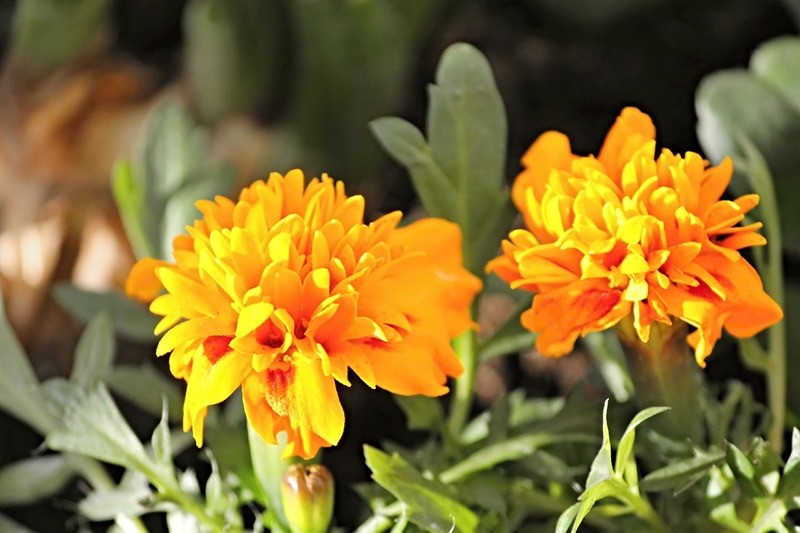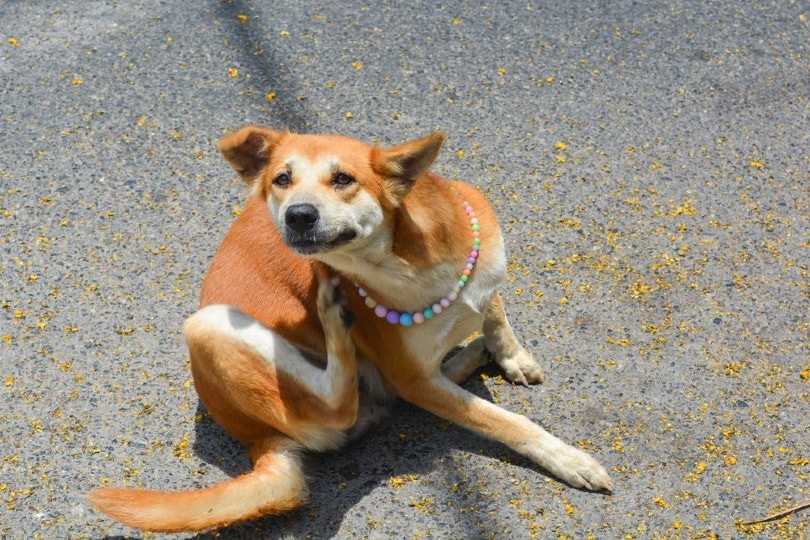Are Marigolds Poisonous To Pets? Yes, marigolds can cause mild irritation, but they are generally considered non-toxic to pets. At PETS.EDU.VN, we want to help you create a safe and beautiful environment for your furry friends. This article dives into the potential risks and benefits of marigolds, offering practical advice for pet owners. We’ll explore how to handle accidental ingestion and how to keep your pets safe around these vibrant flowers.
1. Understanding Marigolds
Marigolds are popular ornamental plants loved for their vibrant colors and ease of care. These cheerful flowers are often used to brighten gardens and outdoor spaces. Here’s a quick overview:
| Feature | Description |
|---|---|
| Appearance | Small bushing plants with vibrant, full blooms |
| Colors | Yellow, orange, white, red |
| Light Requirements | Full sun |
| Soil pH | 6.2–6.5 |
| Difficulty | Easy |



Marigolds are relatively easy to grow. You can start them from seeds directly in the ground after the final frost or indoors if preferred. They thrive in full sun and typically bloom around 8 weeks after planting. While they can tolerate partial shade, it’s essential to ensure the soil isn’t too moist to prevent mold and mildew.
Alt text: Vibrant marigold plants in a garden setting
2. Marigold Flower vs. Extract: What’s the Difference?
While the marigold flower itself can cause mild irritation, calendula oil, an extract from the marigold plant, has several beneficial properties. Calendula oil has been used for years to treat skin abrasions and wounds in dogs and cats. It also shows promise in improving gastric ulcers. VCA Hospitals note its effectiveness in soothing skin issues.
However, caution is advised:
- Pregnant Dogs: Calendula oil should be avoided as it may cause uterine contractions.
- Allergies: Since marigolds belong to the aster family, calendula oil might cause allergic reactions in sensitive animals.
Always consult your veterinarian before using calendula oil on your pet. Discontinue use immediately if any adverse reactions occur.
3. Will Pets Typically Eat Marigolds?
Pets, especially dogs, are known for their indiscriminate eating habits. While there’s nothing particularly attractive about marigolds, some pets might still nibble on them. Some dogs may dig them up out of curiosity, driven by scents of wildlife in the garden. Others might simply be exploring with their mouths.
It’s essential to understand your pet’s behavior and take precautions to prevent them from ingesting garden plants, including marigolds.
4. Potential Risks: Mild Irritation from Marigolds
According to the Pet Poison Helpline, marigolds are considered mildly irritating but generally non-toxic to pets.
4.1. Dermal Exposure
Direct contact with marigolds may cause skin irritation in pets. Signs of dermal exposure include:
- Redness
- Irritation
- Small bumps on the skin
If you notice these symptoms, gently wash the affected area with mild soap and water.
4.2. Ingestion
If a pet eats a marigold, they might experience gastrointestinal upset. Possible symptoms include:
- Queasiness
- Vomiting (in rare cases)
- Diarrhea (especially in sensitive pets)
These symptoms are usually mild and temporary.
Alt text: A dog scratching its ear, indicating potential skin irritation.
5. What to Do If Your Pet Ate a Marigold
If your pet has ingested a marigold, stay calm. Here’s a step-by-step guide:
- Assess the Situation: Determine how much of the plant was eaten.
- Monitor Your Pet: Watch for any signs of irritation or gastrointestinal upset.
- Provide Water: Ensure your pet has access to fresh water to help flush out their system.
- Contact Your Vet: If you notice severe symptoms like persistent vomiting, diarrhea, or lethargy, contact your veterinarian immediately.
Unless a large quantity of marigolds was consumed, your pet will likely recover without intervention.
6. Expert Insights on Marigold Toxicity
Dr. Justine Lee, a board-certified veterinary specialist in emergency and critical care and toxicology, states that marigolds contain irritating sap that can cause localized skin irritation or mild gastrointestinal upset if ingested. The American Society for the Prevention of Cruelty to Animals (ASPCA) also lists marigolds as having the potential to cause mild skin irritation, vomiting, or diarrhea in pets.
7. Top 5 Tips for Keeping Pets Away From Your Flower Garden
Loving pets and gardening can sometimes feel like a balancing act. Here are five effective tips to protect your flower garden from curious pets:
7.1. Create a Physical Barrier
Install fencing around your flower beds to prevent pets from accessing the plants. Consider using decorative fencing that complements your garden’s aesthetic.
7.2. Use Raised Garden Beds
Elevating your flower beds can make it more challenging for pets to reach the plants. Raised beds also improve drainage and soil quality, benefiting your flowers.
7.3. Plant Thorny or Unpleasant Plants
Incorporate plants with thorns or strong scents that pets dislike. Examples include:
- Roses
- Lavender
- Rosemary
7.4. Utilize Deterrent Scents
Pets, especially dogs, have sensitive noses. Use scents that they find unpleasant but are safe for your garden. Effective options include:
- Coffee grounds
- Vinegar
- Citrus peels
- Chili pepper flakes
7.5. Training and Positive Reinforcement
Train your pet to stay out of the garden using positive reinforcement techniques. Reward them with treats and praise when they avoid the flower beds.
8. Marigolds in Pet Products: What to Look For
Marigold extracts, particularly calendula, are sometimes included in pet care products due to their soothing properties. When choosing these products, consider the following:
- Read Labels Carefully: Ensure the product is specifically formulated for pets and contains safe concentrations of marigold extract.
- Consult Your Vet: Before using any new product on your pet, consult your veterinarian, especially if your pet has sensitive skin or allergies.
- Patch Test: Perform a patch test by applying a small amount of the product to a discrete area of your pet’s skin and monitoring for any adverse reactions.
9. Alternative Safe Plants for Your Garden
If you’re concerned about the potential risks of marigolds, consider these pet-safe alternatives for your garden:
| Plant | Description | Benefits |
|---|---|---|
| Sunflowers | Tall, bright flowers that attract pollinators | Edible seeds, cheerful appearance |
| Petunias | Colorful, low-maintenance flowers available in various hues | Long blooming season, attracts butterflies |
| Snapdragons | Tall, elegant flowers with unique, dragon-like blooms | Adds height and interest to the garden, available in many colors |
| Zinnias | Easy-to-grow flowers that attract butterflies and hummingbirds | Heat-tolerant, long-lasting blooms |
| Impatiens | Shade-loving flowers that provide vibrant color in shady areas | Low-maintenance, excellent for borders and containers |
| Herbs (Basil, Mint) | Many herbs are safe for pets and can add flavor to your cooking | Fresh herbs for cooking, pleasant aroma |
| Chamomile | Known for its calming properties | Can be used to make a soothing tea |
Alt text: A veterinarian examining a corgi dog during a check-up.
10. Creating a Pet-Friendly Garden Design
Designing a pet-friendly garden involves thoughtful planning and consideration of your pet’s habits. Here are some key elements to incorporate:
- Designated Digging Area: Provide a specific area where your pet is allowed to dig. Bury toys or treats to encourage them to use this space.
- Safe Pathways: Ensure pathways are wide enough for your pet to navigate comfortably. Use pet-friendly materials like mulch or smooth stones.
- Water Feature: A shallow water feature can provide a refreshing drink for your pet on hot days.
- Shady Spots: Create shaded areas where your pet can relax and escape the sun.
11. Addressing Common Concerns About Garden Safety
Many pet owners worry about the potential dangers lurking in their gardens. Here are some common concerns and solutions:
| Concern | Solution |
|---|---|
| Toxic Plants | Identify and remove toxic plants from your garden. Refer to the ASPCA’s list of toxic plants for dogs and cats. |
| Pesticides and Herbicides | Avoid using chemical pesticides and herbicides. Opt for natural alternatives like neem oil or insecticidal soap. |
| Fertilizers | Choose pet-safe fertilizers or use compost and organic matter to enrich the soil. |
| Sharp Tools and Equipment | Store gardening tools and equipment safely out of reach of pets. |
| Standing Water | Eliminate standing water to prevent mosquito breeding and reduce the risk of waterborne diseases. |
12. The Role of Marigolds in Pest Control
Marigolds are often touted as natural pest repellents. They contain compounds that can deter certain insects and nematodes. Planting marigolds alongside vegetables and other plants can help protect them from pests. However, it’s important to note that their effectiveness varies depending on the specific pest and environmental conditions.
13. Understanding Allergic Reactions in Pets
Although marigolds are generally considered safe, some pets may be allergic to them. Allergic reactions can manifest in various ways, including:
- Skin irritation (itching, redness, hives)
- Respiratory issues (coughing, sneezing, difficulty breathing)
- Gastrointestinal upset (vomiting, diarrhea)
- Facial swelling
If you suspect your pet is having an allergic reaction, seek veterinary care immediately.
14. How to Identify Marigold Varieties
There are several types of marigolds, each with unique characteristics. Here are some common varieties:
- French Marigolds (Tagetes patula): Compact plants with small, double blooms in shades of yellow, orange, and red.
- African Marigolds (Tagetes erecta): Tall plants with large, pom-pom-like flowers in shades of yellow and orange.
- Signet Marigolds (Tagetes tenuifolia): Bushy plants with small, single flowers and edible leaves.
Knowing the specific variety of marigold in your garden can help you better assess its potential risks and benefits.
15. First Aid for Plant Poisoning in Pets
If you suspect your pet has ingested a toxic plant, take the following steps:
- Identify the Plant: Determine the type of plant your pet ingested.
- Assess Your Pet’s Condition: Look for any signs of poisoning, such as vomiting, diarrhea, lethargy, or seizures.
- Contact Your Veterinarian: Call your veterinarian or a pet poison control center immediately. Provide them with information about the plant and your pet’s symptoms.
- Follow Veterinary Advice: Follow your veterinarian’s instructions carefully. They may recommend inducing vomiting, administering activated charcoal, or providing supportive care.
16. Safe Gardening Practices for Pet Owners
To ensure a safe gardening experience for you and your pet, follow these guidelines:
- Plan Ahead: Research plants before introducing them to your garden. Choose pet-safe options whenever possible.
- Supervise Your Pet: Keep a close eye on your pet while they are in the garden.
- Provide Fresh Water: Always have fresh water available for your pet.
- Clean Up Regularly: Remove fallen leaves, flowers, and debris to prevent your pet from ingesting them.
- Store Products Safely: Keep gardening products, such as fertilizers and pesticides, stored in a secure location out of reach of pets.
17. Pet-Safe Weed Control Methods
Weeds can be a nuisance in any garden, but many traditional weed control methods are harmful to pets. Here are some pet-safe alternatives:
- Hand-Pulling: Remove weeds by hand, ensuring you get the entire root.
- Boiling Water: Pour boiling water directly onto weeds to kill them.
- Vinegar: Spray weeds with undiluted white vinegar.
- Mulching: Apply a thick layer of mulch to smother weeds.
- Corn Gluten Meal: Use corn gluten meal as a pre-emergent herbicide to prevent weed seeds from germinating.
18. The Importance of Routine Veterinary Checkups
Regular veterinary checkups are essential for maintaining your pet’s health and well-being. During these visits, your veterinarian can:
- Assess Your Pet’s Overall Health: Identify any potential health issues early on.
- Provide Vaccinations: Protect your pet from infectious diseases.
- Recommend Parasite Prevention: Prevent heartworms, fleas, and ticks.
- Offer Nutritional Guidance: Help you choose the best diet for your pet.
- Answer Your Questions: Address any concerns you may have about your pet’s health and care.
19. Understanding Pet Insurance Options
Pet insurance can help you manage the costs of veterinary care, especially in cases of unexpected illness or injury. When choosing a pet insurance plan, consider the following:
- Coverage: Look for a plan that covers a wide range of conditions and treatments.
- Deductible: Understand how the deductible works and how it affects your premiums.
- Reimbursement Rate: Determine the percentage of covered expenses that the insurance company will reimburse.
- Exclusions: Be aware of any exclusions in the policy, such as pre-existing conditions.
- Waiting Periods: Find out how long you must wait before coverage begins.
20. Common Misconceptions About Pet Poisoning
There are many misconceptions about pet poisoning. Here are a few common ones:
- Myth: All plants are toxic to pets. Fact: Many plants are safe for pets, while others pose a risk.
- Myth: If my pet eats a small amount of a toxic substance, it won’t hurt them. Fact: Even small amounts of certain substances can be harmful to pets.
- Myth: I can treat my pet’s poisoning at home. Fact: It’s essential to seek veterinary care for pet poisoning.
- Myth: Only dogs are at risk of plant poisoning. Fact: Cats and other pets are also susceptible to plant poisoning.
21. Marigolds and Their Role in Companion Planting
Marigolds are frequently used in companion planting to protect other plants from pests. Their strong scent can deter certain insects, and their root secretions can help control nematodes in the soil. Some gardeners plant marigolds alongside tomatoes, peppers, and other vegetables to improve their health and yield.
22. Resources for Identifying Toxic Plants
Several resources can help you identify toxic plants and protect your pets:
- ASPCA Animal Poison Control Center: Provides information on toxic plants and other hazards to pets.
- Pet Poison Helpline: Offers 24/7 veterinary toxicology advice.
- Local Veterinarian: Your veterinarian can provide valuable information and guidance on pet safety.
- University Extension Services: Many universities offer online resources and publications on gardening and plant toxicity.
23. DIY Pet-Safe Pest Control Solutions
Creating your own pet-safe pest control solutions can be both effective and environmentally friendly. Here are a few recipes to try:
- Insecticidal Soap: Mix 1 tablespoon of liquid dish soap with 1 quart of water. Spray on plants to control aphids, spider mites, and other soft-bodied insects.
- Neem Oil Spray: Mix 1 tablespoon of neem oil with 1 quart of water and a few drops of liquid dish soap. Spray on plants to control a wide range of pests.
- Garlic Spray: Crush several cloves of garlic and soak them in water overnight. Strain the mixture and spray on plants to repel insects.
24. Understanding Ethnobotanical Uses of Marigolds
Marigolds have a long history of use in traditional medicine and cultural practices. In some cultures, they are used to treat skin conditions, digestive issues, and other ailments. However, it’s important to note that these uses are not always scientifically validated and should not replace conventional medical treatments.
25. Alternatives to Chemical Fertilizers for a Pet-Safe Garden
Chemical fertilizers can pose risks to pets, causing skin irritation, gastrointestinal upset, and even poisoning. Here are some pet-safe alternatives to consider:
- Compost: Enriches the soil with organic matter and provides essential nutrients for plants.
- Worm Castings: A natural fertilizer that is rich in nutrients and beneficial microorganisms.
- Bone Meal: Provides phosphorus and calcium for strong root development.
- Blood Meal: Provides nitrogen for healthy foliage growth.
- Seaweed Extract: Contains trace minerals and growth hormones that promote plant health.
26. Recognizing Signs of Plant-Related Allergies in Pets
Pets can develop allergies to various plants, including marigolds. Common signs of plant-related allergies in pets include:
- Skin Redness and Itching: Pets may excessively scratch, lick, or bite their skin.
- Hives or Bumps: Allergic reactions can cause raised, itchy bumps on the skin.
- Respiratory Issues: Pets may experience sneezing, coughing, or difficulty breathing.
- Eye and Nasal Discharge: Allergic reactions can cause watery or runny eyes and nose.
If you notice these signs in your pet after they have been exposed to plants, consult your veterinarian for diagnosis and treatment.
27. The Role of Soil Health in Pet Safety
Healthy soil is essential for growing healthy plants, but it also plays a role in pet safety. Contaminated soil can expose pets to harmful pathogens, parasites, and chemicals. To ensure soil health and pet safety:
- Test Your Soil: Have your soil tested to determine its nutrient content and pH level.
- Amend Your Soil: Add organic matter, such as compost or aged manure, to improve soil health and drainage.
- Avoid Chemical Treatments: Use natural and pet-safe methods for controlling pests and diseases in your soil.
- Practice Good Hygiene: Wash your hands thoroughly after working in the garden to prevent the spread of pathogens.
28. Safe Mulching Practices for Pet Owners
Mulch is a valuable tool for controlling weeds, conserving moisture, and improving soil health. However, some types of mulch can be harmful to pets. Here are some safe mulching practices for pet owners:
- Choose Pet-Safe Materials: Opt for mulches made from shredded bark, wood chips, or straw.
- Avoid Cocoa Bean Mulch: Cocoa bean mulch contains theobromine, a toxic substance that can cause poisoning in pets.
- Apply Mulch Sparingly: Avoid piling mulch too high around plants, as this can create a moist environment that attracts pests and diseases.
- Monitor Your Pet: Keep an eye on your pet while they are in the garden to prevent them from ingesting mulch.
29. Creating a Sensory Garden for Pets
A sensory garden can provide a stimulating and enriching environment for pets. Incorporate plants with different textures, scents, and sounds to engage your pet’s senses. Consider including:
- Catnip or Catmint: These plants are highly attractive to cats and can provide hours of entertainment.
- Ornamental Grasses: The rustling sound of ornamental grasses can be soothing to pets.
- Lamb’s Ear: The soft, velvety texture of lamb’s ear can be appealing to pets.
- Chamomile: The calming scent of chamomile can help reduce stress and anxiety in pets.
30. Understanding Zoonotic Diseases
Zoonotic diseases are illnesses that can be transmitted from animals to humans. Some zoonotic diseases can be contracted through contact with contaminated plants or soil. To protect yourself from zoonotic diseases:
- Practice Good Hygiene: Wash your hands thoroughly after working in the garden or handling plants.
- Wear Gloves: Wear gloves when gardening to prevent direct contact with soil and plants.
- Control Pests: Control pests, such as rodents and insects, to prevent the spread of disease.
- Vaccinate Your Pets: Keep your pets up-to-date on their vaccinations to protect them from zoonotic diseases.
At PETS.EDU.VN, we understand that pet owners face unique challenges when it comes to gardening and creating a safe environment for their furry friends. Finding reliable information and trustworthy services can be overwhelming. That’s why we’re here to help.
FAQ: Marigolds and Pet Safety
1. Are all types of marigolds poisonous to pets?
No, marigolds are generally considered non-toxic, but they can cause mild irritation if ingested or if there is dermal contact.
2. What should I do if my dog eats a marigold?
Monitor your dog for any signs of irritation or gastrointestinal upset. Provide plenty of fresh water and contact your vet if symptoms worsen.
3. Can calendula oil be used safely on pets?
Calendula oil can be beneficial for treating skin issues, but consult your vet before use and discontinue if any adverse reactions occur.
4. How can I keep my pets out of my flower garden?
Create physical barriers like fencing, use raised garden beds, or plant thorny vines to deter pets.
5. Are there any pet-safe alternatives to marigolds?
Yes, sunflowers, petunias, snapdragons, and zinnias are all pet-safe options for your garden.
6. What scents deter dogs from flower gardens?
Dogs dislike scents like coffee grounds, vinegar, citrus peels, and chili pepper flakes.
7. Is cocoa bean mulch safe for pets?
No, cocoa bean mulch contains theobromine, which is toxic to pets.
8. What are some signs of plant-related allergies in pets?
Signs include skin redness, itching, hives, respiratory issues, and eye or nasal discharge.
9. Can marigolds help control pests in my garden?
Yes, marigolds can deter certain insects and nematodes when used in companion planting.
10. Where can I find more information about toxic plants for pets?
The ASPCA Animal Poison Control Center and Pet Poison Helpline are excellent resources for identifying toxic plants and getting advice.
We at PETS.EDU.VN are committed to providing you with the resources and support you need to care for your pets.
Do you need more information on creating a pet-safe garden or finding the right pet care products? Visit PETS.EDU.VN today for expert advice, detailed guides, and personalized recommendations. Our comprehensive resources can help you navigate the challenges of pet ownership and ensure your furry friends live happy, healthy lives.
For personalized advice and support, contact us:
- Address: 789 Paw Lane, Petville, CA 91234, United States
- WhatsApp: +1 555-987-6543
- Website: PETS.EDU.VN
Let pets.edu.vn be your trusted partner in pet care.
Alt text: A happy dog in a field of flowers, enjoying a safe and beautiful garden.
